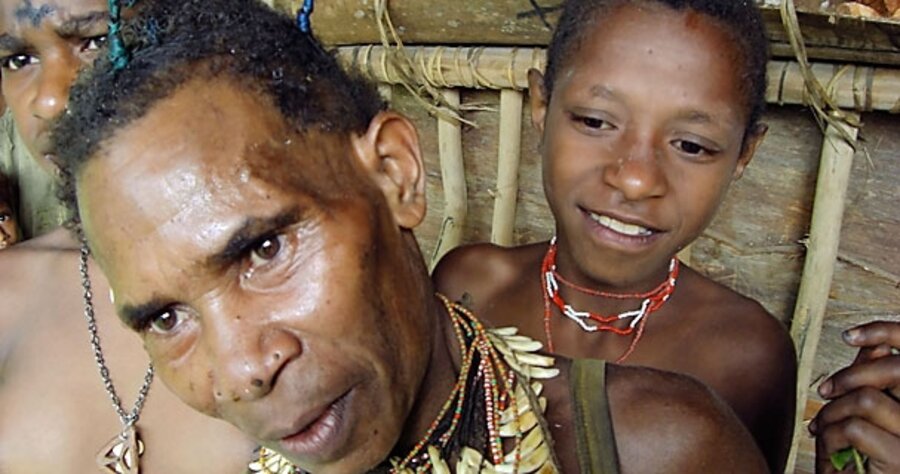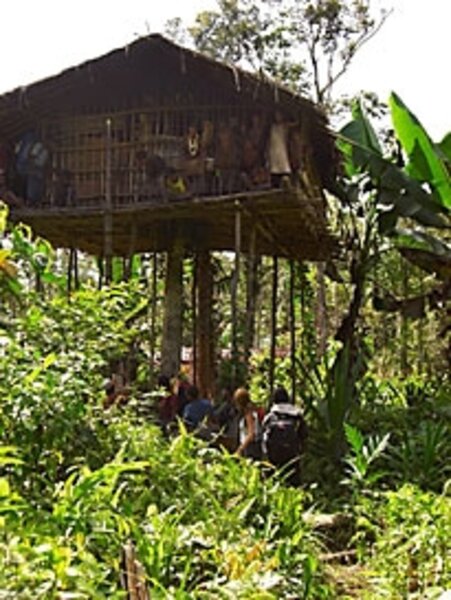Jungle diary, part 3: The art of sleeping in a treehouse
Loading...
| The jungle, southeastern Papua
This is Part 3 of a four-part series. Part 1 | Part 2 | Part 4
Soon, Adam and I and our porters, cook, and guide have settled into a jungle routine: We walk all day with a break in the afternoon for a meal of rice topped with Ramen instant noodles. We look for streams to bathe in, and, in the evening, thwack our way to a treehouse and request permission to join a Korowai family in their home for the night.
Each night offers a different family and a different experience, but the pattern is similar. We hoist ourselves up the shaky wooden poles – hanging on for dear life to the sawtooth notches cut into them – onto the treehouse platform, pump hands vigorously for some time with everyone, saying “Manop, manop,” which means “good, good,” and then hang out entertaining one another and eating beetle larvae (them) or sandwich cookies filled with pineapple cream (us) until bedtime.
The Korowai and Kombai, the isolated tribes of southeastern Papua, live in the trees to protect themselves from floods, animals, and other tribes. They move every few years in search of more game to hunt. These treehouses come in all sizes, but typically have thatched roofs and bamboo partitions between men’s and women’s sections. Dog bones, arrows made from sugar cane, and cassowary feathers decorate the rafters. These dwellings may be up to 80 feet above the ground, though most are about 25 feet up.
The scenes within are usually chaotic, filled with chatting, coughing, and spitting, as well as babies crying and small pigs and dogs making a racket. As Isak (our guide and translator) promised, the deeper we travel into the jungle, the more those we meet seem “authentic” and “primitive.” By the third night, we are staying with a family – the Nandof – who seems as excited by our otherness as we are by theirs.
I sit with the women of the family who are topless, wear skirts made of sago fiber, decorate their hair with tiny mice bones and tails, and wear dog’s teeth as necklaces. I can’t stop taking photos. They, in turn, can’t stop reaching out to touch my white skin and light hair and falling over laughing.
I give the young girls earrings as gifts. They share them easily, taking out the red threads worn as earlobe decorations and giving them to me in return. We pass around their babies and share some sago-root patties. I give my pen to a teenager, who watches me write in my diary, but she cannot figure out how to use it. She gives me a small boiled banana, which tastes exactly like a potato.
Over in the men’s section, Adam is blowing up the balloons we’ve brought from home and twisting them into crowns. Soon, everyone – children and elders alike – is adorned in squeaky pink-and-blue balloon hats and nothing else. Isak, a born-again Christian, asks the Korowai to bow their heads as he says an evening prayer. Animists, but respectful, they do, closing their eyes and clutching the balloons so they don’t float off.
Bedtime happens at about six, when it suddenly becomes pitch dark. I try reading with a flashlight for a while, but the light attracts bugs that go flying directly in my eyes, and I give up. We suggest boiling water for the next day, but no one seems to be listening to us. Isak asks to borrow some calamine lotion.
I can’t sleep. Lying close to the edge of the treehouse 30 feet above the jungle floor, I worry about rolling over and off the edge. A German tourist toppled out of this very family’s old treehouse a few years ago and died, the Korowai tell us. I can’t bear the uncomfortable wooden slats of the floor but don’t dare budge too far in any direction. I drift off to sleep, my dreams filled with falling.
In what seems like the middle of the night, I wake and watch the old men preparing sago patties on a smoldering fire nearby – spitting into their palms to knead the root. A mental note regarding eating sago patties from here on out is made. A little girl with evidence of a fungal skin infection has cuddled up near me. I pull my hand out of my sleeping sheet to see what time it is: 10 p.m.
A piglet in the corner begins to squeal. I need to go to the bathroom. I flash the light again. A mosquito bites my thumb. 10:02. I close my eyes, put my head on my smelly knapsack, squashing the camera inside, and try shifting without actually budging. A small dog walks over me. 10:03.
I am up long before dawn, and watch the sky light up in various shades of red and gray. It’s raining, and the treehouse sways gently. I notice that the clothes I hung up to dry have become, if possible, even wetter. A wild pig darts under the house snorting, and the 30-odd Korowai strewn around me begin to stir. For some reason, I start giggling. A feeling of inexplicable delight and amusement at the situation descends upon me. I take a deep breath and am present, in the here and now, and content.
This is Part 3 of a four-part series. Part 1 | Part 2 | Part 4






